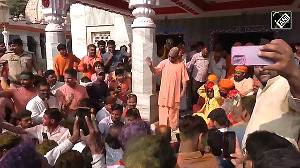Millions of otherwise-sensible Indians can be heard publicly bemoaning that 'a nation of one billion can't even produce a half-way decent cricket team.' Such self-flagellation is based on making performance in cricket a touchstone of patriotism and professionalism. It's a pity that the self-esteem of a billion people has come to rest on one game.
Yet, excellence in sports, in particular cricket, has never been a function of population. That's why Australia, West Indies and Sri Lanka have done well at cricket. It's not just individual excellence that counts in the game. Teamwork, planning and strategising also matter, at which India has traditionally been weak. Besides, uncertainty is built into the very nature of cricket, including the weather, state of the pitch, order of batting, audience response, etc.
To look at the issue soberly, India was ranked Number Six in the world, and wasn't widely expected to win the Cup. It hasn't won a limited-overs tournament played abroad since 1985! It passes comprehension why many people cannot accept that another team may be better than ours, and must instead impute the vilest of causes and motives to our defeat, including lack of 'the killer instinct', loss of will, or absence of national pride. The Sri Lankans played well. The Indians didn't. So that should be the end of the story.
However, we have elevated cricket into a perverse yet powerful passion and denuded it of its content as a sport and source of joy. A cricket victory is seen as affirmation of Indian nationalism -- a sports version of Mera Bharat Mahaan. Nothing excites Indians as much as cricket -- to the exclusion of all other sports. Perhaps cricket turns on Indians even more than politics, leave alone social issues, which periodically divide this country bitterly.
Cricket is more than our national pastime. It claims a higher loss of social time than strikes and lockouts do in industry. Someone has just calculated that if India were to reach the World Cup final, the sport's fans in our 81 million television homes would have 'lost' (spent) 106.5 million man-days in front of the Idiot Box. This is more than 3.5 times the number of man-days lost to strikes and lockouts (30 million) in a year!
This cricket obsession isn't natural or spontaneous. It has been systematically cultivated or manufactured through multi-billion dollar marketing, sales promotion and advertising. Our cricket stars aren't visible on the playground alone. They are omnipresent -- in advertising for colas, processed foods, shampoos, cars, ayurvedic remedies, and eggs -- on Page 3, and in lifestyle and glamour stories churned out daily by hundreds of channels and thousands of newspapers.
This is part of the corporatisation of cricket and its apex organising bodies. The Board of Control for Cricket in India has annual revenues of Rs 500 crores. Last year, it sold telecasting rights for a humongous Rs 2,750 crores! The International Cricket Council sold broadcasting rights for the current and the next World Cup for an even higher $1.1 billion (Rs 4,950 crores). Sony Entertainment Television sold advertising at Rs 5 lakhs for each 10-second spot, raking in an estimated Rs 350 crores to Rs 400 crores. Doordarshan made another Rs 160 crores. Dwarfing this is the money invested in betting, estimated at Rs 4,000 crores.
Now take the star players. Sachin Tendulkar, Sourav Ganguly and Rahul Dravid make Rs 12 crores to 20 crores a year for endorsing products ranging from shoes and cosmetics to life insurance. Ganguly charges an annual fee of close to Rs 1.5 crore per endorsement. Even newcomers like Mahendra Singh Dhoni become multimillionaires overnight.
Corporates now invest in everything, from cricket-related ground events, trophy tours, consumer promotion and glamour shows. The all-pervasive, predatory and manipulative influence of corporations in cricket wouldn't have become possible without ICC, BCCI and even city- and state-level boards being turned into commercialised and mercenary entities.
Cricket now has a uniquely ugly and grotesque side: An international match-fixing mafia. Its scale of operation far exceeds the magnitude of the South African, Pakistani and Indian scandals of the past, itself staggering. Nothing highlights this more starkly than the murder of Bob Woolmer -- cricket's most sordid crisis ever. As more details emerge of this shameful episode, it becomes clear that international cricket is acquiring the same gangster-dominated character as Mumbai's real estate business, where deals are struck or annulled through blackmailing, extortion and outright murder. The shadow of 'D Company' and other mafiosi hangs as ominously over cricket as it does over Mumbai's mill lands.
We are witnessing the transformation of a sport into an organised, criminalised business through its corporate takeover. Whatever corporates touch turns into dust, often bloody dust. Corruption is integral to it. The influence of corporate sponsorship is baneful.
Such influence is now visible in other fields too, especially culture, even 'high culture.' Culture was long monopolised by the State, which would patronise classical music, dance and other performing arts (or rather, performing artistes), and the fine arts. Now, culture is becoming dependent on corporate sponsorship. Sponsorship comes at a high price. Corporates, working through event management companies, typically only want to support 'star' events which generate huge billings or attract high-profile audiences.
Thus, in Hindustani classical music, only a handful of performers -- like Amjad Ali Khan, Pandit Jasraj, Kishori Amonkar, Hariprasad Chaurasia, Shivkumar Shama and Vishwa Mohan Bhatt -- get top-level sponsors, irrespective of quality or integrity. Others get left out -- not because they are less virtuous, but largely because they don't know how to play the sponsorship-publicity game, or lack a glittering Big Star profile. The only exceptions are long-established Sabhas and 3-to-5-day Sammelans, with multiple performances each day.
The 'Star system' is equally dominant in dance, and to a lesser extent, theatre. One reason for this is the paucity of good auditoria and theatres, and their exorbitant rents, going up to Rs 20,000 to Rs 50,000 for an evening. Unless performers somehow find such huge funding, they cannot stage events. And unless their art conforms to the parochial tastes and preferences of corporations and event managers, they won't get funding.
'Big' names count. Quality doesn't. Serious experimental forms and 'non-mainstream' performing arts don't figure in corporate calculations.
The sponsors are omnipotent. They can cancel scheduled performances at the last minute because the audience may not generate enough billings. Often, they nominate their invitees to flood the audience. Recently, two big jazz stars, Herbie Hancock and Wayne Shorter, performed in three Indian cities. In Mumbai, only 10 percent of the seats were sold through tickets, the rest were allotted to sponsors. Their philistine nominees ensured the concert was a dud. Thousands of genuine jazz-lovers couldn't get entry into the hall.
In the past, government- or AIR-sponsored Sammelans would see great artistes performing to empty front-rows reserved for ministers and bureaucrats who wouldn't turn up. Now, the artistes play to equally empty front-rows or pander to dark-suited businessmen more concerned to answer their mobile phone calls than to enjoy the music.
Perhaps the most corrupting influence of corporatisation is to be seen in painting. This art-form has become big as a source of investment, not appreciation. The art market turnover has ballooned from Rs 5 crores in 1997 to over Rs 1,000 crores. So huge is this boom that artists have started employing imitation specialists to produce 'their' work, which they sign. Art auction-houses and commercial ventures have sprouted in city after city to cater to the business investor -- typically, without taste or understanding of quality -- who is looking for an appreciating asset.
As especially grotesque form of such art-commerce amalgamation was a recent venture under which 100 artists and 110 'eminent citizens', including ministers and CEOs, collaboratively produced 120 paintings. So you had Finance Minister P Chidambaram sharing brush-strokes with Anjolie Ela Menon, Ratan Tata and Laxman Shrestha producing a painting over three sittings, and Tina Ambani and Jogen Chowdhury creating extraordinarily shoddy canvas. The artists were all known names, none of them hurting for money. It's shocking that they agreed to destroy the integrity of their discipline by allowing 'eminent citizens' to mess with their paintings.
Corporate sponsorship corrupts. It always will. We must rescue art, culture and sports from it before it's too late






 © 2025
© 2025